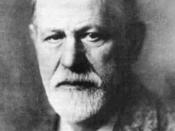The Purpose of Dreams A dream is an involuntary, hallucinatory experience that occurs during sleep. Throughout life, the average person will spend approximately 10 years dreaming, (Silverstein 15) yet people still know surprisingly little about why people dream, and what purpose dreams serve. "In spite of thousands of years of effort, the scientific understanding of dreams has made very little advance"� (Fromm 7). Although scientists still debate about the issue, most people feel that dreams are meaningful and have a purpose. Analyzing dreams may show that dreams are a source of foretelling the future, or an extension of the waking state.
Dream analysis is a process that has been around for nearly four thousand years. It is believed to have originated in ancient cultures and religions, and it is a practice that is still very popular in today's society. Dreams have been analyzed through the use of symbols. They have also been analyzed through the use of laboratory studies; however, there is no completely accurate method for analyzing dreams.
The most common method of analyzing dreams is through the use of symbols, especially for people who believe in dreams as a source of foretelling the future. A symbol is any object, person, or idea that appears in a dream that is thought to represent something else. Seeing a symbol in a dream warns the dreamer of things to come, can determine the source of a problem, or can represent emotions and feelings of the dreamer. Freud stated that "the copious employment of symbols[. . .] for representing certain objects and process is in harmony [with] the regression of the mental apparatus and the demands of censorship"�(72). Analyzing dreams through the use of symbols began in ancient cultures, and it still remains as the most wide spread method of dream interpretation.


